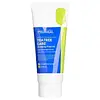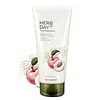What's inside
What's inside
 Key Ingredients
Key Ingredients

 Benefits
Benefits

 Concerns
Concerns

 Ingredients Side-by-side
Ingredients Side-by-side

Water
Skin ConditioningLaureth-1 Phosphate
Glycerin
HumectantLauryl Phosphate
EmulsifyingSodium Laureth Sulfate
CleansingPEG-120 Methyl Glucose Dioleate
EmulsifyingPPG-3 Caprylyl Ether
SolventLauryl Hydroxysultaine
CleansingGlycol Distearate
EmollientCetearyl Alcohol
EmollientMelaleuca Alternifolia Leaf Extract
PerfumingCitric Acid
Buffering1,2-Hexanediol
Skin ConditioningGlyceryl Stearate
EmollientPEG-100 Stearate
PEG-160 Sorbitan Triisostearate
CleansingAlcohol Denat.
AntimicrobialSodium Chloride
MaskingSodium Methyl Cocoyl Taurate
CleansingAcrylates/C10-30 Alkyl Acrylate Crosspolymer
Emulsion StabilisingPotassium Hydroxide
BufferingDimethicone
EmollientButylene Glycol
HumectantCaprylyl Glycol
EmollientMelaleuca Alternifolia Leaf Oil
AntioxidantEthylhexylglycerin
Skin ConditioningDisodium EDTA
Acanthopanax Senticosus Root Extract
Skin ConditioningCentella Asiatica Extract
CleansingPanax Ginseng Root Extract
EmollientAsparagus Cochinchinensis Root Extract
Skin ConditioningPolygonum Multiflorum Root Extract
Skin ConditioningLonicera Japonica Flower Extract
Skin ConditioningCamellia Japonica Seed Oil
EmollientWater, Laureth-1 Phosphate, Glycerin, Lauryl Phosphate, Sodium Laureth Sulfate, PEG-120 Methyl Glucose Dioleate, PPG-3 Caprylyl Ether, Lauryl Hydroxysultaine, Glycol Distearate, Cetearyl Alcohol, Melaleuca Alternifolia Leaf Extract, Citric Acid, 1,2-Hexanediol, Glyceryl Stearate, PEG-100 Stearate, PEG-160 Sorbitan Triisostearate, Alcohol Denat., Sodium Chloride, Sodium Methyl Cocoyl Taurate, Acrylates/C10-30 Alkyl Acrylate Crosspolymer, Potassium Hydroxide, Dimethicone, Butylene Glycol, Caprylyl Glycol, Melaleuca Alternifolia Leaf Oil, Ethylhexylglycerin, Disodium EDTA, Acanthopanax Senticosus Root Extract, Centella Asiatica Extract, Panax Ginseng Root Extract, Asparagus Cochinchinensis Root Extract, Polygonum Multiflorum Root Extract, Lonicera Japonica Flower Extract, Camellia Japonica Seed Oil
Water
Skin ConditioningMyristic Acid
CleansingGlycerin
HumectantStearic Acid
CleansingPotassium Hydroxide
BufferingLauric Acid
CleansingGlycol Distearate
EmollientPolysorbate 20
EmulsifyingCocamidopropyl Betaine
CleansingGlyceryl Stearate
EmollientPEG-100 Stearate
PEG-7 Glyceryl Cocoate
EmulsifyingParfum
MaskingDisodium EDTA
Butylene Glycol
HumectantAnthemis Nobilis Flower Extract
MaskingAspalathus Linearis Extract
Skin ConditioningBorago Officinalis Extract
EmollientCentaurea Cyanus Flower Extract
AstringentLilium Candidum Flower Extract
Skin ConditioningSalvia Officinalis Leaf Extract
CleansingEuterpe Oleracea Fruit Extract
Malpighia Punicifolia Fruit Extract
AntioxidantCitronellol
PerfumingLimonene
PerfumingHexyl Cinnamal
PerfumingLinalool
PerfumingWater, Myristic Acid, Glycerin, Stearic Acid, Potassium Hydroxide, Lauric Acid, Glycol Distearate, Polysorbate 20, Cocamidopropyl Betaine, Glyceryl Stearate, PEG-100 Stearate, PEG-7 Glyceryl Cocoate, Parfum, Disodium EDTA, Butylene Glycol, Anthemis Nobilis Flower Extract, Aspalathus Linearis Extract, Borago Officinalis Extract, Centaurea Cyanus Flower Extract, Lilium Candidum Flower Extract, Salvia Officinalis Leaf Extract, Euterpe Oleracea Fruit Extract, Malpighia Punicifolia Fruit Extract, Citronellol, Limonene, Hexyl Cinnamal, Linalool
 Reviews
Reviews

Ingredients Explained
These ingredients are found in both products.
Ingredients higher up in an ingredient list are typically present in a larger amount.
Butylene Glycol (or BG) is used within cosmetic products for a few different reasons:
Overall, Butylene Glycol is a safe and well-rounded ingredient that works well with other ingredients.
Though this ingredient works well with most skin types, some people with sensitive skin may experience a reaction such as allergic rashes, closed comedones, or itchiness.
Learn more about Butylene GlycolDisodium EDTA plays a role in making products more stable by aiding other preservatives.
It is a chelating agent, meaning it neutralizes metal ions that may be found in a product.
Disodium EDTA is a salt of edetic acid and is found to be safe in cosmetic ingredients.
Learn more about Disodium EDTAGlycerin is already naturally found in your skin. It helps moisturize and protect your skin.
A study from 2016 found glycerin to be more effective as a humectant than AHAs and hyaluronic acid.
As a humectant, it helps the skin stay hydrated by pulling moisture to your skin. The low molecular weight of glycerin allows it to pull moisture into the deeper layers of your skin.
Hydrated skin improves your skin barrier; Your skin barrier helps protect against irritants and bacteria.
Glycerin has also been found to have antimicrobial and antiviral properties. Due to these properties, glycerin is often used in wound and burn treatments.
In cosmetics, glycerin is usually derived from plants such as soybean or palm. However, it can also be sourced from animals, such as tallow or animal fat.
This ingredient is organic, colorless, odorless, and non-toxic.
Glycerin is the name for this ingredient in American English. British English uses Glycerol/Glycerine.
Learn more about GlycerinGlyceryl Stearate is a mix of glycerin and stearic acid.
It is used to stabilize the mixing of water and oil ingredients. By preventing these ingredients from separating, it can help elongate shelf life. It can also help thicken the product's texture.
As an emollient, it helps soften skin and supports barrier-replenishing ingredients.
In cosmetics, Glyceryl Stearate is often made from vegetable oils or synthetically produced.
This ingredient may not be fungal-acne safe
Fun fact: The human body also creates Glyceryl Stearate naturally.
Learn more about Glyceryl StearateGlycol Distearate serves as a pearlizing or opacifying agent in cosmetic products.
It's often included in cleansers and haircare products to give them a lustrous or shimmering appearance.
It is derived from stearic acid, a natural fatty acid commonly found in vegetable oils and animal fats.
Glycol Distearate isn't fungal acne safe.
Learn more about Glycol DistearatePeg-100 Stearate is an emollient and emulsifier. As an emollient, it helps keep skin soft by trapping moisture in. On the other hand, emulsifiers help prevent oil and water from separating in a product.
PEGS are a hydrophilic polyether compound . There are 100 ethylene oxide monomers in Peg-100 Stearate. Peg-100 Stearate is polyethylene glycol ester of stearic acid.
Potassium hydroxide is commonly known as caustic potash. It is used to fix the pH of a product or as a cleaning agent in soap. In cleansers, it is used for the saponification of oils.
Sapnification is the process of creating fatty acid metal salts from triglycerides and a strong base. During this process, Potassium Hydroxide is used up and is not present in the final product.
Using high concentrations of Potassium Hydroxide have shown to irritate the skin.
Learn more about Potassium HydroxideWater. It's the most common cosmetic ingredient of all. You'll usually see it at the top of ingredient lists, meaning that it makes up the largest part of the product.
So why is it so popular? Water most often acts as a solvent - this means that it helps dissolve other ingredients into the formulation.
You'll also recognize water as that liquid we all need to stay alive. If you see this, drink a glass of water. Stay hydrated!
Learn more about Water